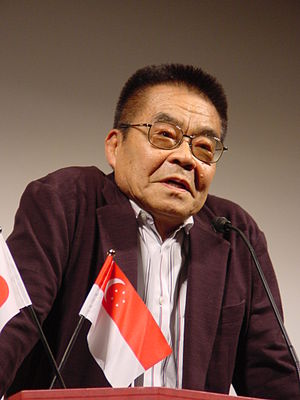

Yoshihiro Tatsumi is one of those cartoonists who is more influential than they are really known — at least in America. He was one of the first creators of (and the coiner of the term) gekiga, or alternative manga, using grittier, more real-world-based stories as opposed to the major commercial type stuff. In the US, though only one rare volume appeared in English in 1987, and it turned out that was a shoddily copied bootleg. Somehow, a copy of that bootleg found its way into Adrian Tomine‘s hands, and it influenced him greatly. Tomine’s best known for his Optic Nerve series, which similarly features quiet stories of real life. Not often as noirish as Tatsumi’s work — a more low-key type of quiet desperation on par with Dan Clowes‘ later Eightball issues.
To repay that inspiration, however, Tomine’s curating a series of hardcover reprints and English translations done with the blessing (and occasional artistic touch-up) by Tatsumi himself. The book is quite well done — heavy paper, good, strong ink printing — lots of care done in the translations to make them flow normally.
Tatsumi’s individual stories are quite good as well — like Tomine’s work, it is often a slice-of-life style, though typically the characters are removed from Tomine’s young, middle class, hipster-types. The first story is about a man who purposely loses an arm on the job for the money; the next is about another man who travels around Japan showing pornographic films for business meetings. Near the end of the volume is a story of a bedridden man who has a secret sex slave in his apartment. Y’know, stuff you’d be a little surprised to see in the next issue of Optic Nerve.
Tatsumi’s art is quite good; it’s in a similar vein to a lot of the Japanese manga art from the ’60s that I’ve seen, but the different settings make it stand out, as does his innate talent. While Tatsumi’s main innovations are with the type of storytelling he does and his art tends to take a backseat to that — he’s not a bad artist by any means. Just because he doesn’t break new frontiers with his drawing doesn’t mean he’s any less of an artist. And I think with this kind of thing it’s better that way — to show people what can be done with comic book storytelling, it can often help to present it in a style that’s familiar to underline what is UNfamiliar in it. Too much unfamiliarity can be a turnoff to a mass audience not ready for it — which means your innovations are for naught if they don’t reach an audience.
I do think the book isn’t arranged quite right; it seems awfully frontloaded with stories of shrewish women — one that makes you think when you first pick it up that you’re in for a collection of stories by someone with Issues. After the first few stories, you realize that’s not the case — though there’s a difference between a reader who has already taken the book home and is relieved at the change, and a person thumbing through in a bookstore. I know there’s at least one other volume out (in addition to the autobiographical A Drifting Life), so hopefully the balance problem has been fixed in the next books in the series.
That aside, however, it’s good to see an unknown master get his due — or, well, at least in this country, anyway. The folks in Japan have been hip to him for quite some time. But, I suppose it’s now our turn to be late to the party.
